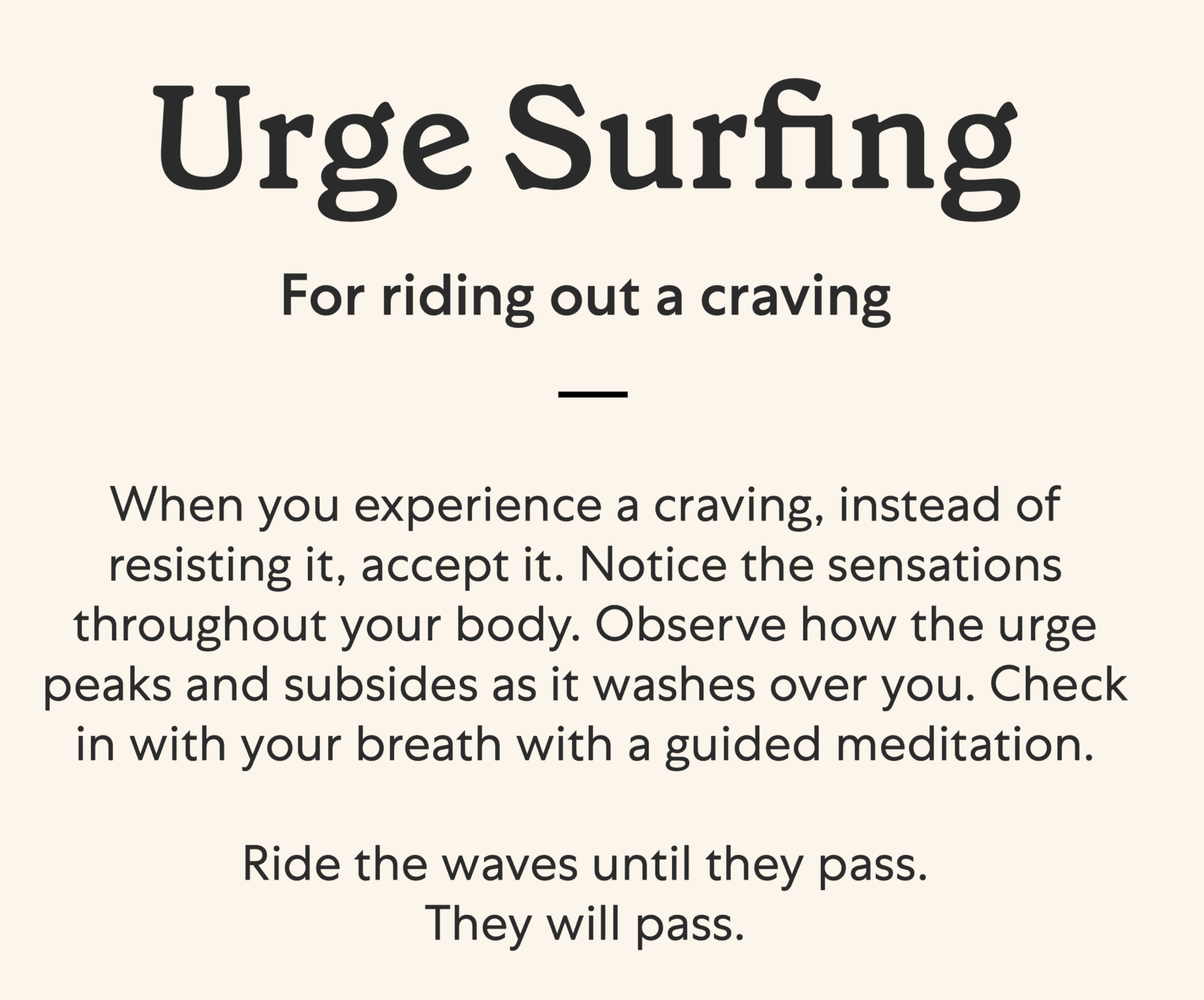If you’ve experienced alcohol cravings while navigating sobriety or moderation, guess what? You’re human. Alcohol cravings are a natural and even to-be-expected part of the alcohol recovery timeline, especially in the earlier days. My patients often ask me, “How do I stop alcohol cravings for good?”
The reality is that the sobriety or moderation journey is often a non-linear one, and you may confront cravings at any point in your journey. However, the good news is, with the right support and online alcohol treatment, you can learn how to manage cravings, and ultimately reduce their frequency and intensity. Cravings are not a sign of weakness. You have agency, and with this resource, a wealth of craving management tools at your disposal.
How to address alcohol cravings 101
Generally, a craving is defined as a subjective experience of wanting to use a drug. The experience is highly variable depending on numerous factors, including your mood, environment, where you are in the alcohol recovery timeline, and beyond. Cravings follow a period of abstinence from drinking alcohol, whether that’s a few hours or a few years. As a reminder, just because you experience a craving, it does not mean you’ve lost control or haven’t made meaningful progress.
In fact, it’s an opportunity to exercise your control and show your progress. Cravings can last anywhere from a few seconds to even a few hours. It’s essential to keep in mind that cravings are temporary and that they will eventually go away.
It’s helpful to visualize cravings as the ebb and flow of the ocean waves. Sometimes the waves are big, and other times they are so small that you barely notice them. Riding out a craving can be like riding a wave. Check out some more information about ‘urge surfing’ to put this into practice.

While intense cravings can increase your risk of drinking, they do not have to lead to drinking. Through planning and practice, you can learn how to manage cravings more effectively. The management of cravings can be broken down into two parts:
What you do before you start having cravings and what you do when you are having cravings.
Let’s dive in.
Pre-cravings work: Decreasing the frequency and intensity of cravings
Engaging in your sobriety or moderation toolkit prior to having cravings is a really effective way to reduce the intensity of cravings. While craving management is useful, like treating any condition, prevention work can reduce future severity. Eliminating cravings altogether may not be realistic, but you can decrease the frequency and the intensity of cravings to be more manageable. The first tool for doing so? Understanding triggers.
Although cravings often feel unpredictable, there are usually triggers that lead to them. Triggers are teachers, and play a key role in craving management. The next time you have a craving, take note of your mental and physical state.
- Where are you?
- What time of the day is it?
- How do you feel?
- What are you doing?
As you continue to keep track of your cravings in a journal or document, you will begin to recognize patterns and be able to identify specific triggers. Triggers can be anything associated with drinking alcohol and can be categorized into internal and external triggers.
Identify & address internal triggers
Common internal triggers include negative emotions (and sometimes even positive emotions), physical discomfort, boredom, and stress. Internal triggers can have a strong influence on your desire to drink. Frequent drivers of cravings are feelings of depression and anxiety. Those feelings are uncomfortable, and alcohol can provide immediate, short-lived relief.
Your brain learns that behavior, and begins to crave alcohol whenever you are feeling depressed or anxious. However, drinking alcohol only masks these feelings and actually intensifies these negative emotions. It can be scary to identify depressive or anxious thoughts as a trigger, but it also provides a path towards healing. You can unlink depression and alcohol and anxiety and alcohol and treat both simultaneously.
If you are dependent on alcohol, it’s possible that you will experience alcohol withdrawal symptoms when you significantly cut down alcohol consumption or stop drinking. You should consult your physician before quitting alcohol cold turkey or cutting down. Severe withdrawal symptoms include delirium tremens and hallucinations, which can be dangerous or life-threatening without medical supervision. If you believe you are experiencing acute withdrawal symptoms, you should contact your provider immediately and visit https://findtreatment.gov/ to find a location to get supervised detox near you.
Identify & avoid external triggers
External triggers can include people, places, and things that you associate with alcohol. Our brain loves efficiency, and aims to make our behaviors more automatic by grouping things together. When you drink alcohol and artificially increase the dopamine levels in your brain, your brain tries to remember everything associated with that temporary pleasure to repeat the behavior. For example, you might come to associate certain activities, friends, and venues with drinking.
Typically it’s easier to control external triggers than internal triggers, and the most effective action to take is to avoid these external triggers as much as possible. If you have alcohol in your home, get rid of it or put it away in a place where it’s very inconvenient for you to reach.
If you are conditioned to drink while watching TV from your favorite couch, rearrange them. The goal is to weaken the brain’s connection between the triggers and alcohol consumption. This process can include trial and error, and that’s part of the process. You can also join Monument’s online alcohol support groups to hear what’s worked for other members.
During a craving: Tools for managing alcohol cravings
Even with your best efforts, both mild and intense alcohol cravings can still occur. It does not mean you did anything wrong or failed in any capacity. In fact, in the early phases of your recovery, you are expected to have cravings. Remember that cravings are temporary, and even if it doesn’t feel like it in a given moment, they will eventually pass. Identifying an alcohol craving early on presents more opportunity to manage it, and prevents escalation. Having the right tools at hand is the key to successfully managing cravings. Here are tips I share with my patients.

Be mindful.
The very first step in managing an alcohol craving is recognizing it. Be curious about the experience. How strong is it? Do you feel it in your body? How does it feel? Where is it located? Be kind to the sensation of cravings—your perspective and attitude toward cravings influence how you manage them.
Many people’s instinct is to feel bad when they have cravings. If you start creating negative associations with cravings, you will experience more negative emotions, which could further trigger you to drink. Understand that cravings are natural, and as described before, present an opportunity for you to put your skills into practice.
Do not just rely on your willpower.
One of the most common mistakes people make when managing cravings is relying too much on ‘willpower.’ Many psychologists define willpower as the ability to delay gratification, resisting short-term temptations in order to meet long-term goals. Using your willpower can be one of the tools in your toolkit, but it shouldn’t be the only one.
Willpower is a finite resource that is often unpredictable and varies throughout the day. Additionally, relying on your willpower to resist cravings can take up a lot of effort and energy. When you’re tired at the end of your stressful day and have very little willpower left, you are in a very vulnerable situation, especially if you don’t have other strategies.
Preventing relapse through self-care
Remember the “Five Ds”
The “Five Ds” are more popularly known in the management of nicotine cravings, but are just as helpful in managing alcohol cravings.
- Delay: If you are working on moderating your drinking (instead of abstaining altogether), try extending the time between when you experience a craving and when you have a drink. If you wait long enough, your craving may just disappear, and you might not feel the need to drink.
- Distract: Do something else. Keep yourself busy. Occupy your mind with a hobby, TV show, or meditation. If you’re able to, doing physical activity is a great way to distract yourself and release tension. Get up, and go outside. Take a walk. Lean on alcohol-free activities that bring you joy.
- Drink water: You may be thirsty when you are craving alcohol. Drink plenty of water throughout the day to avoid thirst becoming your trigger.
- Deep breathing: Take a deep breath in and exhale slowly and fully. Activate your parasympathetic system in order to relax.
- Discuss: Reach out to other people who understand what you’re going through. Post in the Monument Community at any time or attend one of the many alcohol support groups. You are not alone in this.
Medication to reduce cravings and therapy
In addition to the behavioral tools like the 5 Ds, there are also other tools that can be extremely effective in craving management. One of those is medication to stop drinking. There are three FDA-approved medications to treat alcohol use disorder: naltrexone, acamprosate, and disulfiram. Two of these medications, naltrexone, and acamprosate, are shown to help with cravings.
Naltrexone helps reduce cravings by blocking opioid receptors in the brain. You can read more about naltrexone benefits to learn more, and if you think medication could be right for you, you can work with a physician on the Monument platform to discuss your options. It’s important to remember that while medications like naltrexone are a great tool, there is no ‘miracle drug’ to completely stop cravings.
Another great research-supported tool is online alcohol therapy. Working with a therapist to form new, healthier associations and coping mechanisms is an excellent option for anyone looking to change their relationship with alcohol. They can help you address internal and external triggers, practice mindfulness, build coping skills, and much more.

Now what? The long-term craving timeline
If you’ve put all of the above tools into practice, you might be wondering, ‘how long until I stop experiencing cravings?’ As with most stages of the alcohol recovery timeline, the answer is unique to you. That said, as you remove triggers and develop new coping techniques, you should experience fewer and less intense alcohol cravings.
The cravings may be so mild that you don’t even recognize them as cravings. It’s also important to note that your brain never entirely forgets its positive associations with alcohol, especially when confronted with stress and negative feelings. For that reason, it’s important to keep your tools fresh in your mind, and continue to engage in your sobriety or moderation toolkit as long as it’s serving you. You are more powerful than your cravings, and have all the tools at your disposal.
Explore treatment plans at Monument
Disclaimer: Our articles and resources do not constitute clinical or licensed therapy or other health care services. If you need counseling or therapy services please contact a licensed provider. If this is a medical emergency, call 911.